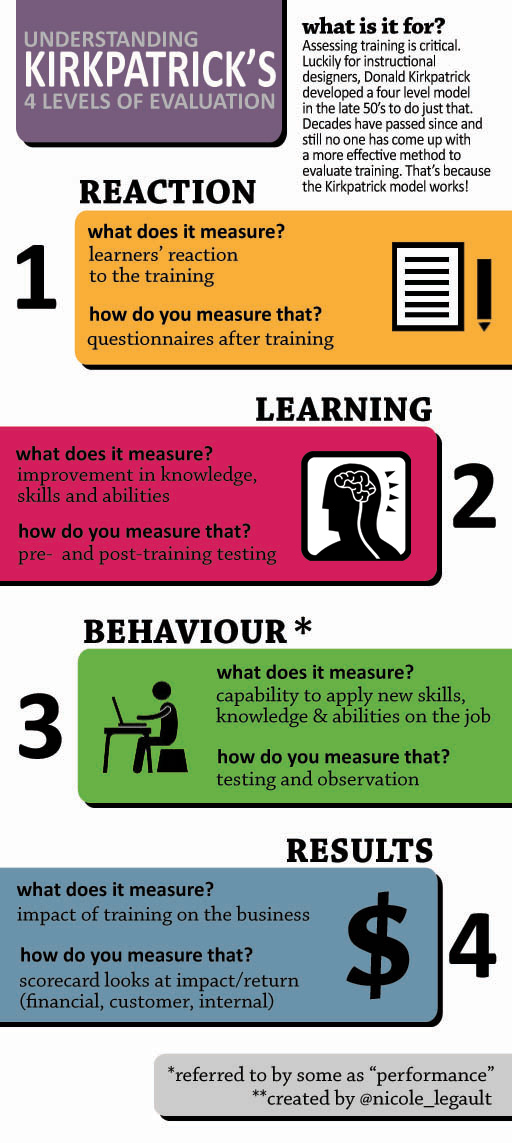I have created a graphical representation of the ADDIE model. ADDIE (Analysis, Design, Development, Implementation & Evaluation) is the methodology used by the majority of instructional designers for training development. There may be some debate as to whether certain tasks belong in the design or development phase. Also, certain tasks may have been omitted due to space constraints. I tried to focus on the most important aspects of each phase.
Infographic: Kirkpatrick’s 4 Levels of Evaluation
20 Tips For Working With Subject Matter Experts (SMEs)
Working with subject matter experts (SMEs) is an important part of being an instructional designer. A SME is someone who is an expert in their domain, role, or job; you’ll likely have to work with one at some point in your training career.
You’ll meet with your SME to identify learning objectives, gather source content, and more. Some SMEs are friendly, knowledgeable, and keen to participate; they are more than willing to spend time with you and help you out. In other instances, you might be confronted with a know-it-all SME that you don’t really enjoy working with. Regardless of personality, it’s important to have a good relationship with your SMEs, because they are critical to the success of your instructional design projects.
Here are 20 tips to follow to build a strong relationship with your SMEs and get the most out of your time with them.
Introduce Yourself
It’s always polite to introduce yourself to your SME. This can be done in an email, a phone call or a face-to-face visit, depending on the project. You want to let your SME know who you are, what your role is, and that you look forward to working with them. Building a good relationship with your SME will go a long way in helping you get the time and information you need from them.
Get Management Buy-In
Management’s level of buy-in is a crucial factor. If possible, you want to get management to commit the SME to a certain amount of hours working on the training project. This will help reduce the SME’s stress when they have to be away from their regular duties that still need to get done.
Respect Their Profession
Whether it’s a secretary, a data entry clerk, a doctor, or a line cook, it is important to be respectful of what someone does for a living. Every job deserves respect. and there are subject matter experts in every industry and every domain.
Do Your Homework
Gather as much information about the subject as you can prior to meeting with your SME. Going into the meeting with a baseline of knowledge demonstrates that you are interested in learning and value their time.
Be Friendly
This is a straight-forward tip, but don’t underestimate how critical the SME is to the overall success of your project. If you are friendly and conversational with them, they’ll be more willing to give you the time of the day.
Use Plain Language
When you meet with your SMEs, avoid using complicated training terminology or learning jargon. Don’t toss around terms like ADDIE model, Blooms Taxonomy, or Kirkpatrick Levels of Evaluation. These words most likely means nothing to your subject matter expert.
Don’t Waste Time
Ensure the time you spend with a SME is valuable and well-spent. Be on time for meetings and be considerate of their other work obligations such as meetings and other deadlines they may have. If you know Monday is the busiest day of the week for your SME, be considerate and book meetings on other days if possible.
Schedule Short Meetings
This is especially important when the SME is helping out in a project but still needs to complete all their regular duties. It’s considerate to check with them before scheduling a meeting that will be more than an hour long.
Plan Your Meetings
Before going into a meeting with a SME, have a plan for what you want to cover and how you want to use this valuable time. Make sure to prioritize what’s most important and cover that material first.
Ask The Right Questions
Write out a list of relevant and thoughtful questions that you want to cover with your SME ahead of time. If more questions come up as they are talking or explaining, write them down so you don’t forget.
Provide Questions Beforehand
In addition to writing out a list of questions in advance, consider providing the questions to your SME a few days prior to your meeting. This gives them time to think about what you want to cover and may allow them to prepare some of their answers ahead of time.
Identify Realistic Scenarios
Using scenarios in e-learning is a great way to bring your content to life and create meaningful engagement for your learners. Ask your SMEs questions like “In what type of situation will learners use this information?” Try to have your SME provide you with a variety of scenario examples that are relevant to the subject matter. These will help to provide background information and additional context for learners.
Ask for Demonstrations
Often it’s helpful to see how something is done rather than just hearing it described step-by-step. This is particularly true when it comes to software or application training, it’s critical for the SME to walk you through the steps. This ensures the process is accurate, and it might lead to questions that you need to ask them.
Keep It Simple
SMEs will sometimes go off into deep explanations, or use big words, that aren’t really required. Keep them on track and stick to only what is relevant to your learners.
Show Examples
Show your SME some examples of e-learning courses that are similar in terms of content and engagement as to what you’re trying to achieve. Whether you need to create a step-by-step job-aid document or an interactive e-learning module with scenarios, this helps ensure you and your SME are on the same page about what the end result will look like.
Record Meetings
You can use a small recorder that you can buy for cheap to record in person meetings in a meeting room. If you’re doing anything on a computer with your SME, such as walking through the steps of a process in an application, make sure to use a screen recording tool to capture everything on video.
Keep Management Involved
CC them on any appropriate communications with SMEs and keep an accurate record of tasks completed by SMEs.
Define Tasks Clearly
If there are specific action items for the SME to complete, spell it out for them clearly in an email, with a clear timeline. You should also include anyone who needs to be CC’d on the email such as a project manager or a project stakeholder.
Share Deadlines
Keep the SMEs in the loop about timelines and deadlines, so they have clear knowledge of when things are due.
Give Credit When It’s Due
When a SME has been really helpful, has devoted a lot of time, or has provided you with really helpful information, send them (and the project manager) an email to recognize and thank them.
Hopefully following these tips will help you build a solid relationship with your SMEs. This will go a long way in ensuring you have a smooth project and get what you need, when you need it. Follow me on Twitter for more training tips and tricks.
What Does An Instructional Designer Do?

When I tell people that my job title is Instructional Designer (ID), I am often met with a blank stare and the following question: “What’s that?”. I don’t blame people for not knowing what an Instructional Designer does because there was a time in the not-so-distant past when I would’ve had the same reaction. I’ve since come to learn that what IDs do is critical to ensuring organizations have a properly trained workforce. Instructional design is a great field to have a career in; globalization and evolving technologies have created an ongoing need for well-designed and effective training materials.
Read on to find out what the duties of a typical Instructional Designer include.
Analyze and Assess Training Needs
One of the key tasks that an ID will carry out is a training needs analysis. This is when an ID gets a clear understanding of what training is needed, why it’s needed, and what the business goals are.
The ID also assesses the training audience, to determine their background and demographics, in order to develop training that is audience appropriate.
In addition to this, the ID will interview stakeholders, employees, and managers to gather source content. The ID might also review existing training materials, create a project plan, and develop the learning objectives.
Work with Subject Matter Experts (SMEs)
The ID does not necessarily have any knowledge or expertise in the subject that learners need to be trained on. IDs are experts in training design… they can’t be experts in everything!
The job of being the expert actually belongs to the appropriately titled Subject Matter Expert (SME). The SME is an expert in his or her job or domain; the ID works with the SME to extract the knowledge and information that needs to be imparted onto others.
Working with SMEs usually involves meetings where the SME explains a process or demonstrates how a task is done accurately. The ID will record this information and include it in the training. Read More: 20 Helpful Tips for Working with Subject Matter Experts)
Develop Training Materials
Instructional designers apply ID methodologies such as the ADDIE model and Adult Learning Principles, to create instructionally sound training materials. Whether it be a PowerPoint presentation, a one page job-aid document, or a highly interactive e-learning module, instructional designers often are the ones to not only design but also develop and create the final training materials.
Implement Evaluation Strategies
One of the most important aspects of the instructional designers job is evaluating the effectiveness of training. An organization cannot measure the Return on Investment (ROI) of training without proper evaluation techniques that provide insights into what performance changes and metrics have changed.
Instructional designers use principles such as Kirkpatrick’s Levels of Evaluation and Keller’s ARCS Model to measure training effectiveness. Common methods of evaluation used by instructional designers include feedback forms, using metrics and KPIs to measure change, and using pre- and post-training evaluations.
These are just some of the tasks that IDs carry out as a part of their job. Depending on the project and their skill-set, they may do more or less of the things identified here.


